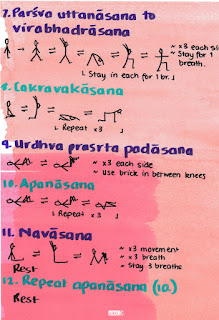This week I have decided to brave the waters of the cakra-s, well one cakra (mūlādhāra), but I hesitate to discuss or mention cakra-s in my teaching because my impression is that the word is overused, misunderstood and mispronouced (phonetically: it's not sharkra it's chuckra). And then there is the apprehension as to whether my understanding is adequate. When I embarked on the "yoga journey" I gobbled up anything and everything I read or heard and it wasn't until I started studying yoga with my teacher that I realised there is plenty of B.S. written and discussed in the yoga world by people with limited knowledge and understanding. Of course, the cakra-s are no exception and potentially one of the topics with the most B.S. surrounding them. Anyway, this my attempt at explaining mūlādhāra cakra and it's significance in our post-partum yoga practice.
Briefly, the cakra-s are energetic points in the body (not the physical body, the subtle body) where energy (prāna) is concentrated. These points in the body control how prāna flows throughout the whole body. A very short, two sentence explanation on what is prāna: prāna is our life energy, it is the life in every living thing. We cannot see or control prāna directly, instead we use techniques like prānāyāma to affect how well prāna flows in the body. In yogic physiology, at the junction points (cakra-s), if prāna is flowing well, then the body functions optimally.
The root cakra (known in sanskrit as mūlādhāra) assists in supporting conception, growth and nourishment of the baby. It is also the cakra which is related to our sense of self, our sense of belonging and considered the starting point of our spiritual development. It is located at the perineum for men and the cervix for women hence its connection to reproduction. Its associated element is Earth which means when it is functionally optimally we feel grounded and calm. The table at the end of this post summarises the different aspects of the cakra according to the yoga system. A great article on the cakra-s has been written by Dr David Frawley if you would like to read more.
Part of the post-partum āsana practice is to strengthen and support the abdominal muscles and the pelvic floor. With this area of the body being supported by mūlādhāra, we encourage prāna to concentrate here through āsana and prānāyāma techniques. Our final reflection in class this week will consolidate the āsana and prānāyāma and help stimulate this area of the body in a more subtle and powerful way. Below is the practice for you to continue at home. I hope you can join us tomorrow (Tuesday June 5th) 11am at Bikram Yoga Kawana.
Cakra |
Mūlādhārā
|
Meaning |
Mūla = root or
base.
Adhārā =
support.
Dha = to hold.
|
Element |
Earth element, prthvi.
|
Bija Mantra |
Lam (pronounced
“lum”).
|
Lotus Flower |
Four petals,
red.
|
Yantra/symbol |
The yantra =
yellow square.
In the middle of
symbol there is a red triangle pointing downwards.
|
Location |
Perineum (male)
or cervix (female).
|
Jnana Indriya |
Large intestine.
|
Developmental Stages |
Sense of
belonging, your tribe.
Psychological
interpretation – security, grounding, food, comfort. This is
important in 0-3y/o ~ important in development: sense of self, belonging,
security, attachment, fed, looked after, tribe, friends, belonging &
feeling safe.
|
Animal/Vehicle |
Seven trunked
elephant.
The seven trunks
are the seven cakra-s and the 7 minerals vital to the human body. E.g. calcium, copper, iodine, iron,
magnesium, manganese, potassium.
|
Tan Mantra & Karma Indriya |
Tan mantra
(sense) = smell & nose & secretion/excretory organs (large
intestines). Governs movement of the
legs.
|
Deity |
Brahman, the
creator (male deity). Dakini (female)
the goddess who controls the elements of the skin & the body.
|
Miscellaneous |
Ida, pingala
& sushumna originate from mūlādhārā cakra.
Kundalini
resides in this cakra.
|




No comments:
Post a Comment